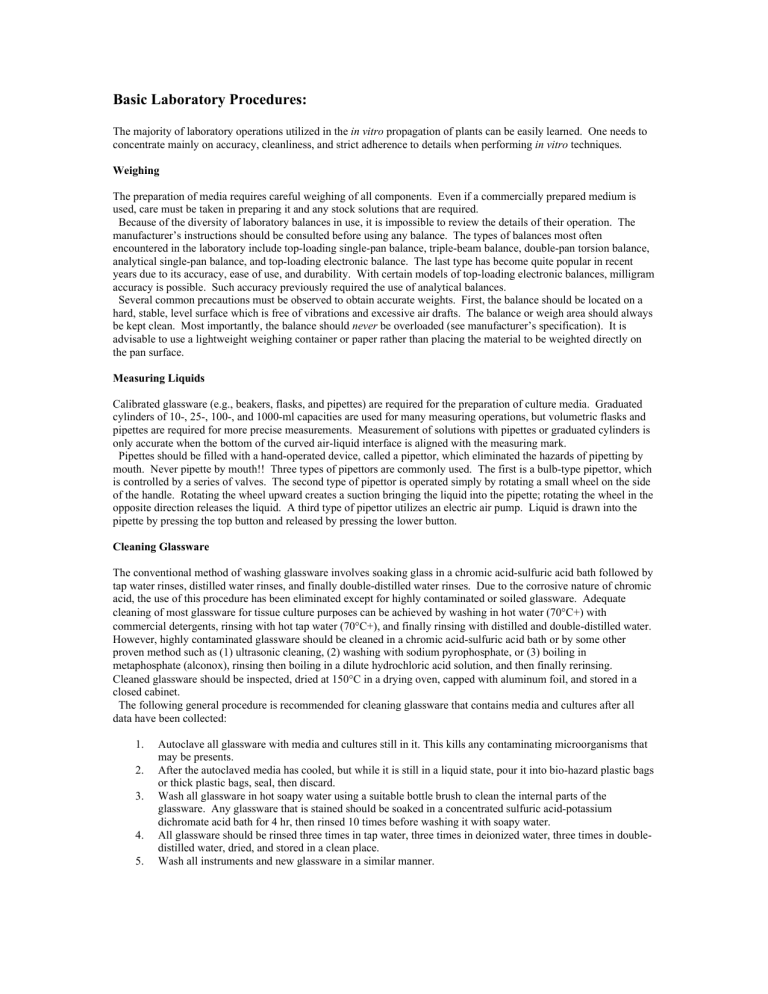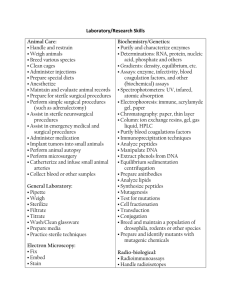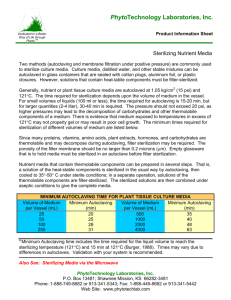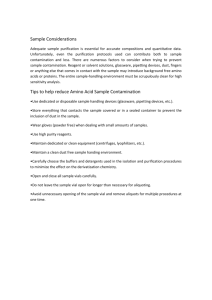
Basic Laboratory Procedures: The majority of laboratory operations utilized in the in vitro propagation of plants can be easily learned. One needs to concentrate mainly on accuracy, cleanliness, and strict adherence to details when performing in vitro techniques. Weighing The preparation of media requires careful weighing of all components. Even if a commercially prepared medium is used, care must be taken in preparing it and any stock solutions that are required. Because of the diversity of laboratory balances in use, it is impossible to review the details of their operation. The manufacturer’s instructions should be consulted before using any balance. The types of balances most often encountered in the laboratory include top-loading single-pan balance, triple-beam balance, double-pan torsion balance, analytical single-pan balance, and top-loading electronic balance. The last type has become quite popular in recent years due to its accuracy, ease of use, and durability. With certain models of top-loading electronic balances, milligram accuracy is possible. Such accuracy previously required the use of analytical balances. Several common precautions must be observed to obtain accurate weights. First, the balance should be located on a hard, stable, level surface which is free of vibrations and excessive air drafts. The balance or weigh area should always be kept clean. Most importantly, the balance should never be overloaded (see manufacturer’s specification). It is advisable to use a lightweight weighing container or paper rather than placing the material to be weighted directly on the pan surface. Measuring Liquids Calibrated glassware (e.g., beakers, flasks, and pipettes) are required for the preparation of culture media. Graduated cylinders of 10-, 25-, 100-, and 1000-ml capacities are used for many measuring operations, but volumetric flasks and pipettes are required for more precise measurements. Measurement of solutions with pipettes or graduated cylinders is only accurate when the bottom of the curved air-liquid interface is aligned with the measuring mark. Pipettes should be filled with a hand-operated device, called a pipettor, which eliminated the hazards of pipetting by mouth. Never pipette by mouth!! Three types of pipettors are commonly used. The first is a bulb-type pipettor, which is controlled by a series of valves. The second type of pipettor is operated simply by rotating a small wheel on the side of the handle. Rotating the wheel upward creates a suction bringing the liquid into the pipette; rotating the wheel in the opposite direction releases the liquid. A third type of pipettor utilizes an electric air pump. Liquid is drawn into the pipette by pressing the top button and released by pressing the lower button. Cleaning Glassware The conventional method of washing glassware involves soaking glass in a chromic acid-sulfuric acid bath followed by tap water rinses, distilled water rinses, and finally double-distilled water rinses. Due to the corrosive nature of chromic acid, the use of this procedure has been eliminated except for highly contaminated or soiled glassware. Adequate cleaning of most glassware for tissue culture purposes can be achieved by washing in hot water (70°C+) with commercial detergents, rinsing with hot tap water (70°C+), and finally rinsing with distilled and double-distilled water. However, highly contaminated glassware should be cleaned in a chromic acid-sulfuric acid bath or by some other proven method such as (1) ultrasonic cleaning, (2) washing with sodium pyrophosphate, or (3) boiling in metaphosphate (alconox), rinsing then boiling in a dilute hydrochloric acid solution, and then finally rerinsing. Cleaned glassware should be inspected, dried at 150°C in a drying oven, capped with aluminum foil, and stored in a closed cabinet. The following general procedure is recommended for cleaning glassware that contains media and cultures after all data have been collected: 1. 2. 3. 4. 5. Autoclave all glassware with media and cultures still in it. This kills any contaminating microorganisms that may be presents. After the autoclaved media has cooled, but while it is still in a liquid state, pour it into bio-hazard plastic bags or thick plastic bags, seal, then discard. Wash all glassware in hot soapy water using a suitable bottle brush to clean the internal parts of the glassware. Any glassware that is stained should be soaked in a concentrated sulfuric acid-potassium dichromate acid bath for 4 hr, then rinsed 10 times before washing it with soapy water. All glassware should be rinsed three times in tap water, three times in deionized water, three times in doubledistilled water, dried, and stored in a clean place. Wash all instruments and new glassware in a similar manner. Sterilization The most tedious parts of in vitro techniques are sterilizing plant materials and media and maintaining aseptic conditions once they have been achieved. Bacteria and fungi are the two most common contaminants observed in cell cultures. Fungal spores are lightweight and present throughout our environment. When a fungal spore comes into contact with the culture media used in tissue culture, conditions are optimal for germination of the spore and subsequent contamination of the culture. Sterilizing Culture Rooms and Transfer Hoods Large transfer rooms are best sterilized by exposure to ultraviolet (UV) light. Sterilization time varies according to the size of the room and should only be done when there are no experiments in progress. Ultraviolet radiation is harmful to the eyes. Transfer rooms can also be sterilized by washing them 1-2 times a month with a commercial brand of antifungal spirocyte. Smaller transfer rooms and hoods also can be sterilized with UV lights or by treatment with bactericides and/or fungicides. Laminar flow hoods are easily sterilized by turning on the hood and wiping down all surfaces with 95% ethyl alcohol 15 min before initiating any operation under the hood. Culture rooms should be initially cleaned with a detergent-brand soap and then carefully wiped down with a 2% sodium hypochlorite solution or 95% ethyl alcohol. All floors and walls should be washed gently on a weekly basis with a similar solution; extreme care must be used to avoid stirring up any contamination that has settled. Commercial disinfectants such as Lysol, Zephiram, and Roccal diluted at manufacturer’s recommended rates can be used to disinfect work surfaces and culture rooms. Sterilizing glassware and Instruments Metal Instruments are best sterilized using a glass bead sterilizer, Product Number S636 or S637. These sterilizers heat to approximately 275-350° C and will destroy bacterial and fungal spores that may be found on your instruments. The instruments simply need to be inserted into the heated glass beads for a period of 10 to 60 sec. The instruments should then be placed on a rack under the hood to cool until needed. Metal instruments, glassware, aluminum foil, etc., can also be sterilized by exposure to hot dry air (130°-170°C) for 2-4 hr in a hot-air oven. All items should be sealed before sterilization but not in paper, as it decomposes at 170°C. Autoclaving is not advisable for metal instruments because they may rust and become blunt under these conditions. Instruments that have been sterilized in hot dry air should be removed from their wrapping, dipped in 95% ethyl alcohol, and exposed to the heat of a flame. After an instrument has been used, it can again be dipped in ethyl alcohol, reflamed, and then reused. This technique is called flame sterilization. Safety is a major concern when using ethyl alcohol. Alcohol is flammable and if spilled near a flame will cause an instant flash fire. This problem is compounded in laminar flow hoods due to the strong air currents blown towards the worker. Fires commonly start when a flamed instrument is thrown back into the alcohol beaker. In case of fire do not panic. Limiting the supply of oxygen can easily put out fires. Autoclaving is a method of sterilizing with water vapor under pressure. Cotton plugs, gauze, labware, plastic caps, glassware, filters, pipettes, water, and nutrient media can all be sterilized by autoclaving. Nearly all microbes are killed by exposure to the super-heated steam of an autoclave for 10-15 minutes. All objects should be sterilized at 121°C and 15 psi for 15-20 min. Sterilizing Nutrient Media Two methods (autoclaving and membrane filtration under positive pressure) are commonly used to sterilize culture media. Culture media, distilled water, and other stable mixtures can be autoclaved in glass containers that are sealed with cotton plugs, aluminum foil, or plastic closures. However, solutions that contain heat-labile components must be filter-sterilized. Generally, nutrient media are autoclaved at 15 psi and 121°C. For small volumes of liquids (100 ml or less), the time required for autoclaving is 15-20 min, but for larger quantities (2-4 liter), 30-40 min is required. The pressure should not exceed 20 psi, as higher pressures may lead to the decomposition of carbohydrates and other thermolabile components of a medium. Since many proteins, vitamins, amino acids, plant extracts, hormones, and carbohydrates are thermolabile and may decompose during autoclaving, filter sterilization may be required. A Millipore or Seitz filter can be used; the porosity of the filter membrane should be no larger than 0.2 microns (µm). Empty glassware that is to hold media must be sterilized in an autoclave before filter sterilization. Nutrient media that contain thermolabile components can be prepared in several steps. That is, a solution of the heatstable components is sterilized in the usual way by autoclaving, then cooled to 50°-60° C under sterile conditions; in a separate operation, solutions of the thermolabile components are filter-sterilized. The sterilized solutions are then combined under aseptic conditions to give the complete media. Sterilizing Plant Material Obtaining sterile plant material is difficult, and despite any precautions taken, 95% of cultures will end up contaminated if the explant is not disinfected in some manner. Because living materials cannot be exposed to extreme heat and retain their biological capabilities, plant organs and tissues are sterilized by treatment with a disinfecting solution. Solutions used to sterilize explants must preserve the plant tissue but at the same time destroy any fungal or bacterial contaminants. Once explants have been obtained, they should be washed in a mild soapy detergent before treatment with a sterilizing solution. Some herbaceous plant materials (e.g., African violet leaves) may not require this step, but woody material, tubers, etc., must be washed thoroughly. After the tissue is washed, it should be rinsed under running tap water for 1030 min and then be submerged into the disinfectant under sterile conditions. All surfaces of the explant must be in contact with the sterilant. After the allotted time for sterilization, the sterilant should be decanted and the explants washed at least three times in sterile distilled water. For materials that are difficult to disinfect, it may be necessary to repeat the treatment 24-48 hr before making the final explants. This allows previously unkilled microbes time to develop to a stage at which they are vulnerable to the sterilant. Sterile Culture Techniques Successful control of contamination depends largely upon the operator’s techniques in aseptic culture. You should always be aware of potential sources of contamination such as dust, hair, hands, and clothes. Obviously, your hands should be washed, sleeves rolled up, long hair tied back, etc. Washing your hands with 95% ethyl alcohol is an easy precautionary measure that can be taken. Talking or sneezing while culture material is exposed also can lead to contamination. When transferring plant parts from one container to another, do not touch the inside edges of either vessel. By observing where contamination arises in a culture vessel, you may be able to determine the source of contamination. In plant tissue culture, small pieces of plant tissue are placed on or in a medium rich in nutrients and sugar. If bacteria or fungi come in contact with the plant tissue or the medium, the culture becomes contaminated. The contaminants (bacteria and fungi) will use nutrients from the medium and the plant, which quickly destroys the plant tissue. Our aim is to surface sterilize the plant tissue and put it on a sterile growth medium without any bacteria or fungi getting on the plant or medium. This is not easy because bacteria and fungal spores are in the air, on us, in us, and under us! When you see sunlight shining in a window you can, from certain angles, see dust particles in the air. There are hundreds of bacteria attached to each dust particle. A horizontal laminar flow unit is designed to remove the particles from the air. Room air is pulled into the top of the unit and pushed through a HEPA (High Energy Particle Air) filter with a uniform velocity of 90 ft/min across the work surface. The air is filtered by the HEPA filter so nothing larger than 0.3 um (micrometer) can pass through. This renders the air sterile. The flow of air from the unit discourages any fungal spores of bacteria from entering. All items going inside the unit should be sterile or sprayed with ethanol or isopropyl alcohol. They will remain sterile unless you contaminate them. A transfer cabinet provides an enclosed environment that is not sterile but can be sterilized. A cardboard box lined with aluminum foil or plastic, or a well-cleaned aquarium, provides a shield to reduce contamination. A box that is 2024 inches wide, 20-24 inches high, and 12-16 inches deep provides a good work area. Working inside any of these does not guarantee success. The following precautions are necessary for all work areas. 1. 2. 3. 4. 5. 6. The room should be swept and if possible, mopped. Each work surface should be washed with a 10% CloroxR, LysolR, or other disinfectant solution. Doors and windows should be closed. Air conditioners and fans should be turned off. If possible, each student must have a work space that can be properly treated against contamination. For example, the box or aquarium mentioned earlier, or a piece of poster paper lying on the table to indicate the student’s sterile workspace. Have spray bottles filled with 70% ethanol or isopropanol (never methanol) placed so each student has access to one bottle. Spray everything going into the sterile area. 7. 8. 9. 10. Have a central supply area so all necessary items can be picked up and taken to the workspace as needed. Items can be returned to the central supply area after being used. Sterile instruments will be needed for each person. One way to accomplish this is to have a ½-pint jar of 70 % ethanol for scalpels and short forceps. When tissue has to be positioned in a vessel, long 10-inch forceps are needed. The long forceps need to be placed deep enough in alcohol so that any part of the forceps that might come into contact with the vessel is sterilized. A 100-ml graduated cylinder can be used to hold the alcohol and long forceps. A ½-pint jar of sterile water is needed for dipping the instruments to remove the residual alcohol that might dry out plant tissues. A sterile work surface is needed on which to place the sterile tissue to trim it. The easiest thing to use is a sterile petri dish. If you have glass ones, you can autoclave and reuse them. Presterilized plastic dishes are used and discarded. Spray the bag of dishes with 70 % alcohol before you open it and place the desired number of unopened dishes at each station. Each dish has two sterile surfaces-the inside top and inside bottom. Long hair should be tied back or covered. Hands should be washed, not scrubbed (scrubbing dries hands and creates flakes of skin that have bacteria) and sprayed with 70 % ethyl or isopropyl alcohol or coated with isopropyl alcohol gel. Gloves and masks provide extra protection. Do not talk while performing sterile operations. Do not lean over your work. Keep your back against the backrest of your chair. Try to work with your arms straight: this position may feel awkward, but it will reduce contamination. Do not pass nonsterile items over sterile areas or items. Reach around rather than over. Make your movements smooth and graceful so that you do not disturb the air more than is necessary. Work quickly though, the longer it takes to manipulate the tissues the greater the chance of contamination. Have only the necessary items in sterile work area. Remove items that are no longer needed as quickly as possible. Act out each step before beginning so that you understand what you are about to do. Store cultures in a well-lit area (not in direct sunlight), and do not allow the temperature to exceed 800 F where the cultures are stored. If you are placing cultures under lights, use only fluorescent light. The preferred schedule is 16 hours of light and 8 hours of dark. Check the temperature prior to placing the cultures under the lights because temperature will build even under fluorescent lights. Check cultures every 3-5 days for contamination. Slimy areas mean bacterial contamination while fuzzy areas are due to fungal contamination. Do not open containers that are contaminated. The contaminants could be disease causing or pathogenic. The only safe way to dispose of these is to autoclave (or pressure-cook) them for 15 minutes at 15 psi. Contaminated plastic dishes can be placed inside a large can or autoclavable bag to be sterilized before discarding. Determining pH The pH of a solution is a measure of the concentration of hydrogen ions in the solution. The pH scale extends from very acid (0) to very alkaline (14) with 7 being the “neutral” point. The pH of most culture media is adjusted to 5.7 ± 0.1 before autoclaving. The pH can influence the solubility of ions in nutrient media, the ability of agar to gel, and the subsequent growth of cells. Thus accurate determination and control of the pH of tissue culture media are necessary. Generally, pH is determined with a pH meter.


